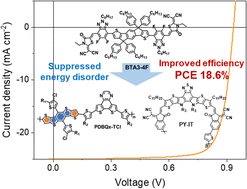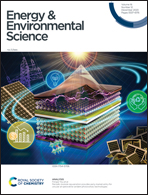Suppression of energy disorder by incorporating a small-molecule acceptor into binary all-polymer solar cells†
Abstract
Organic photovoltaic cells based on disordered materials suffer significant energy losses that limit the power conversion efficiencies (PCEs). For all-polymer solar cells (all-PSCs), the complicated blend morphology caused by the high probability of chain entanglement will exacerbate this situation. Here, we designed an alternating copolymer donor, PDBQx-TCl, based on dithieno[2,3-d:2′,3′-d′]benzo[1,2-b:4,5-b′]dithiophene and dithieno[3,2-f:2′,3′-h]quinoxaline units and studied its application in all-PSCs. By blending with the polymer acceptor PY-IT, the device obtained a moderate PCE of 16.8%. We then incorporated a small-molecule acceptor, BTA3-4F, into the PDBQx-TCl:PY-IT blend, which not only tuned the optical absorption and aligned energy levels but also suppressed the energy disorder by optimizing the blend morphology. As a result, the ternary device recorded an outstanding PCE of 18.6%, which is much higher than the binary all-PSC. This work demonstrates that suppressing energy disorder by adding small molecules into binary all-PSCs is a feasible approach to improve photovoltaic performance.



 Please wait while we load your content...
Please wait while we load your content...